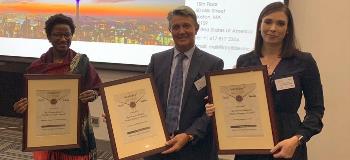The Outlook for Interest Rates and Inflation in 2021
The lack of inflationary pressure combined with calls to boost the economy could spur on further interest rate cuts.
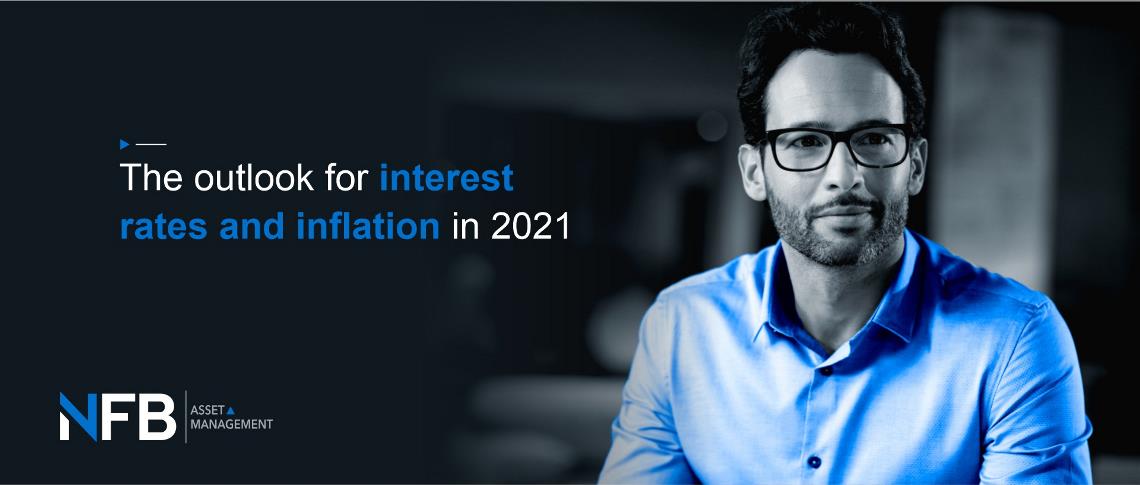
Its primary tool in achieving this mandate is the continuous review and potential adjustment of the repurchase rate, currently at 3.5%. Adjustments to the repurchase rate are usually, but not always, done at regularly scheduled meetings of the SARB’s Monetary Policy Committee which is next due to meet in January 2021.
The SARB is under both political and social pressure to also target economic growth which is sometimes accompanied by a demand for “full employment”. Arguably, the economically devastating effects of the Covid-19 pandemic cannot be offset by further reductions in the repurchase rate which goes some way to explaining why pressure for changes in, or enhancements to the SARB’s mandate receded toward the end of 2020. Similarly, calls for the SARB to lose its independence have also receded in the last few months. There is no question that a change in the bank’s independence would imply a change in its mandate. This risk is well known and has already been absorbed into market pricing.
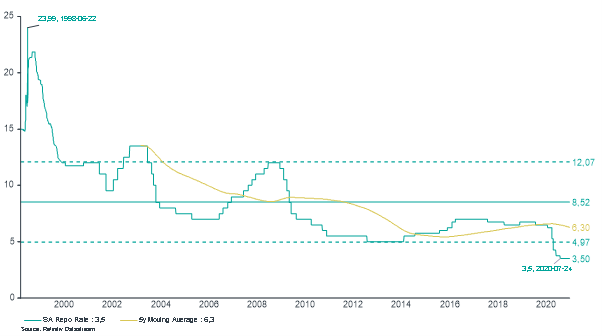
South African Repurchase Rate
The current year-on-year change in CPI, as published by Statistics SA in the first week of December for the November month-end, is 3.2%, within the SARB’s target range but close to the bottom.
Barring a handful of breaches of both the upper and lower limit of the inflation-targeting range, the 12-month rate of change in CPI has been contained to within the range since at least 2010. The most recent breach being in June this year when inflation was at 2.22%.
The average rate of inflation over the last five years is 4.8%, almost exactly the mid-point of the range and therefore in line with the SARB’s stated preference. Whether the official rate of inflation accurately approximates what consumers experience is an important debate, compounded by the under-resourcing of Statistics SA which led to a delay in the reporting of CPI in the first half of 2020.
If Statistics SA lacks the resources to publish data on time, whether it has the resources to continually ensure the representativeness of CPI becomes questionable. The organisation officially reviews the basket of goods that make up CPI every five years. The next revision is due in 2022.
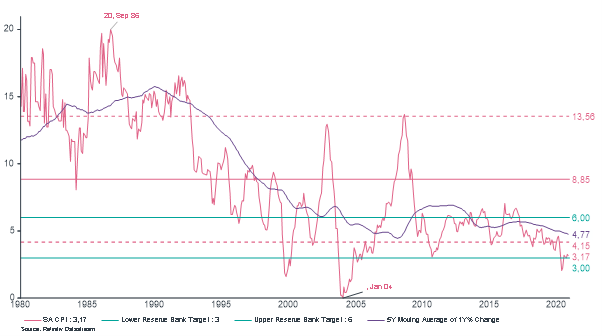 Year-on-year change in South African CPI
Year-on-year change in South African CPI
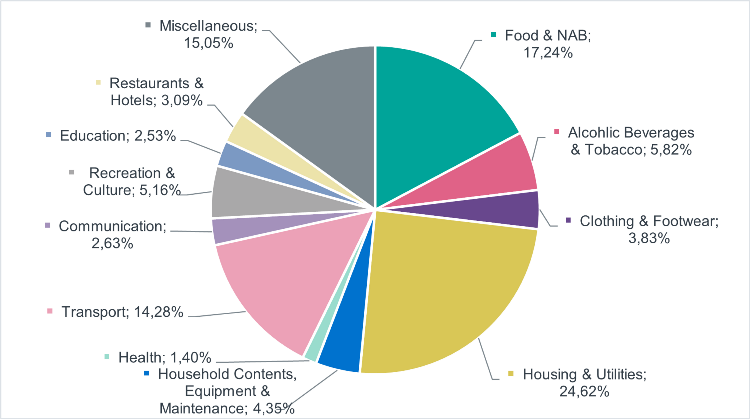
South African CPI Components
Food and non-alcoholic beverages constitutes one of the three largest components of the CPI basket with a weight of 17%. The others include housing and utilities (25%) and transport (14%).
Neither housing nor transport are inflationary at present. Transport is in fact deflationary at -1.4% currently but it is also one of the most volatile inflation components and could easily return to the inflation targeting range relatively quickly. This month’s large increase in retail petrol prices will have an impact.
The area that is of interest from an inflationary perspective is food which has been running at about 3% year-on-year for years. However, in the most recent data set food was up 5.8%; very close to the upper limit of the SARB’s target range. The inflation target, however, does not apply to the individual CPI components.
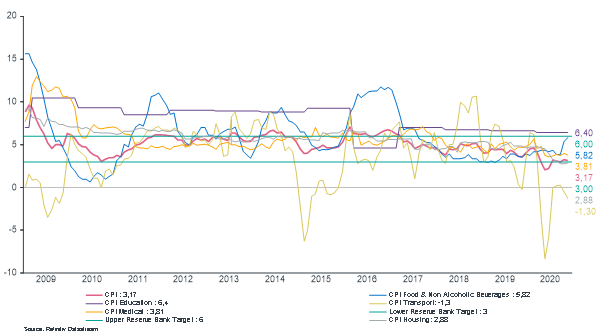
Year-on-year change in South Africa CPI Components
The difference between the yield on a South African government-issued nominal bond and the equivalent duration inflation-linked bond provides a useful market indicator for expected inflation over the term to maturity of the pairs of bonds. Unfortunately, South Africa does not run constant maturity nominal and inflation-linked bonds so this type of analysis is only ever an approximation. Nevertheless, the three pairs of bonds we track indicate that over the short-term inflation is expected to average just over 3%, over the medium-term around 5.5% and over the longer-term a little over 6%. These figures are all comfortably within or near the SARB’s inflation-targeting range.
Interestingly, the difference between the three outlooks has never been as wide as it is now; indicating an almost complete absence of inflationary pressure in the short-term which must accelerate meaningfully to get the average inflation rate over the long-term back up to 6%.
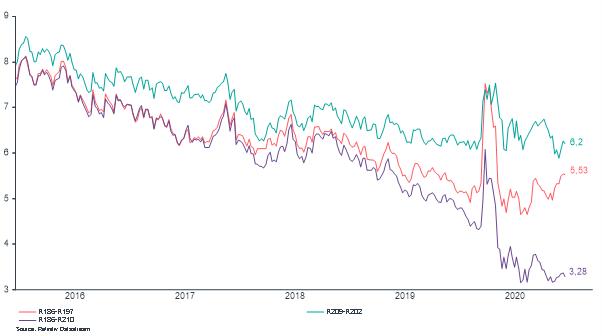 Implied break even inflation rates
Implied break even inflation rates
Given the lack of current inflationary pressure, other than food prices for which we only have a single data point, and the market’s entirely benign inflation outlook, there is little to no pressure on the SARB to lower the repurchase rate further than it already has within the strict confines of its mandate. Interest rates are already at all-time lows. Even real interest rates (arrived at by subtracting the current rate of inflation from the repurchase rate) are close to all-time lows. Widening the frame of reference to include economic growth and/or unemployment clearly creates the impetus to cut rates that is not there from an inflation perspective; especially since President Cyril Ramaphosa’s Covid-19 adjusted level 3 lockdown Family Meeting at the end of December.
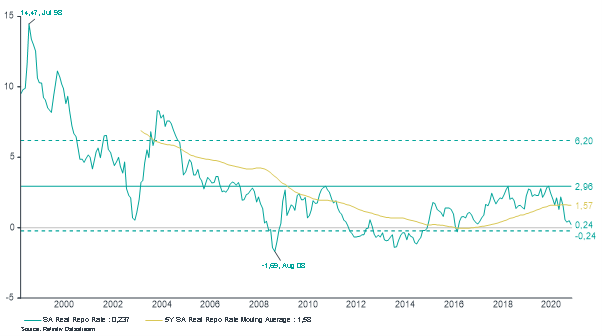 South African real repurchase rate
South African real repurchase rate
It is possible to compare three-month forward rate agreements (FRA’s) with three-month negotiable certificate of deposit (NCD) rates to derive the market’s expectations for interest rate changes. Using this methodology, the market anticipates a repurchase rate cut of 25 basis points most likely at the SARB’s January Monetary Policy Committee Meeting; with a greater than 50% probability of a further 25 basis cut thereafter.
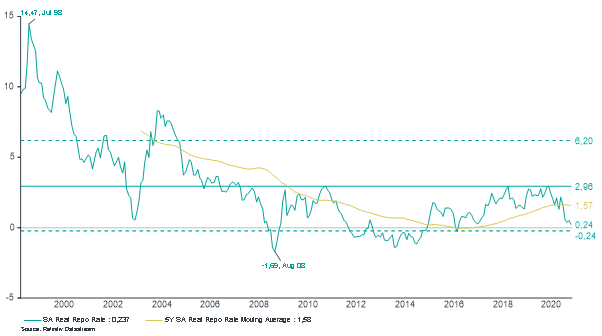 Implied interest rate changes
Implied interest rate changes
There are two global trends worth mentioning in conclusion. The first is the US Fed’s recently expressed tolerance for higher inflation over the medium term so that inflation averages 2% over the review period. In our view this is irrelevant to the SARB as the inflation target is a range and the bank could easily allow inflation to drift towards 6% so that the average is around 4.5% without having to officially say anything to this effect.
The second trend is that many central banks, particularly in developed markets, have explicitly targeted negative real interest rates as a component of their Covid-19 response efforts. Despite the obvious fact that those central banks are developed market central banks and ours is an emerging market, with a 25 basis point cut in interest rates and just a 25 to 50 basis point increase in CPI, South African interest rates are likely to be negative in real terms anyway.
The outlook for interest rates has changed meaningfully in the last month, from largely unchanged to now including a reasonable probability of two 25 basis point cuts. The first of which may soon occur. The inflation outlook, however, remains entirely benign. Given that the SARB’s mandate is to target inflation, we surmise that interest rate changes would then be almost entirely about protecting the economy as much as possible from further devastating impacts of lockdown restrictions that are not already being experienced.
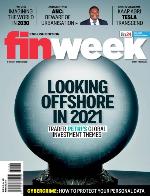 This article was written exclusively for Finweek and was published in the 21 January 2021 edition. You can access the the original article here.
This article was written exclusively for Finweek and was published in the 21 January 2021 edition. You can access the the original article here.





.jpg?sfvrsn=3ccd9277_0&size=350)

.png?sfvrsn=38ac0893_0&size=350)






























